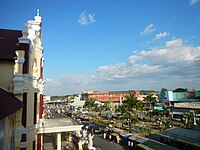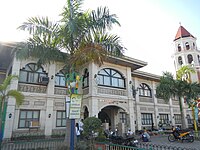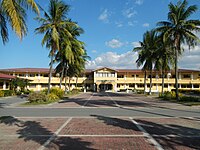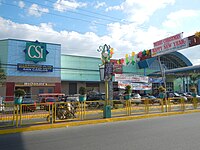world.wikisort.org - Philippines
San Carlos, officially known as the City of San Carlos (Pangasinan: Siyudad na San Carlos; Ilocano: Siudad ti San Carlos; Tagalog: Lungsod ng San Carlos), is a 3rd class component city in the province of Pangasinan, Philippines. According to the 2020 census, it has a population of 205,424 people. [3]
This article needs additional citations for verification. (September 2013) |
San Carlos
Binalatongan | |
|---|---|
Component city | |
| City of San Carlos | |
 Downtown area | |
 Flag  Seal | |
| Nickname(s): Heart of Pangasinan Linguistical center of the Pangasinan language | |
 Map of Pangasinan with San Carlos highlighted | |
OpenStreetMap  | |
 San Carlos Location within the Philippines | |
| Coordinates: 15°55′41″N 120°20′56″E | |
| Country | Philippines |
| Region | Ilocos Region |
| Province | Pangasinan |
| District | 3rd district |
| Founded | 1578 |
| Cityhood | January 1, 1966 |
| Barangays | 86 (see Barangays) |
| Government | |
| • Type | Sangguniang Panlungsod |
| • Mayor | Julier C. Resuello |
| • Vice Mayor | Joseres S. Resuello |
| • Representative | Rose Marie J. Arenas |
| • City Council | Members |
| • Electorate | 126,283 voters (2022) |
| Area | |
| • Total | 169.03 km2 (65.26 sq mi) |
| Elevation | 12 m (39 ft) |
| Highest elevation | 172 m (564 ft) |
| Lowest elevation | 0 m (0 ft) |
| Population | |
| • Total | 205,424 |
| • Density | 1,200/km2 (3,100/sq mi) |
| • Households | 47,785 |
| Economy | |
| • Income class | 3rd city income class |
| • Poverty incidence | 12.73% (2018)[4] |
| • Revenue | ₱941,440,557.59 (2020) |
| • Assets | ₱2,524,697,822.57 (2020) |
| • Expenditure | ₱699,468,079.24 (2020) |
| • Liabilities | ₱655,712,949.03 (2020) |
| Service provider | |
| • Electricity | Central Pangasinan Electric Cooperative (CENPELCO) |
| Time zone | UTC+8 (PST) |
| ZIP code | 2420 |
| PSGC | |
| IDD : area code | +63 (0)75 |
| Native languages | Pangasinan Ilocano Tagalog |
| Website | sancarloscitypangasinan |
It is the most populated city in Pangasinan and the entire Ilocos Region.
San Carlos City is 19 kilometres (12 mi) from Lingayen and 208 kilometres (129 mi) from Manila.
History
Pre-colonial
San Carlos was already a prosperous community since pre-colonial times. It was formerly part of a town called "Binalatongan". Binalatongan was the capital of Luyag na Caboloan, an ancient kingdom, which includes the present-day provinces of Tarlac, Zambales, Nueva Ecija, La Union, Pangasinan, and Benguet) ruled by King Ari Kasikis. The name of Binalatongan was derived from the abundance of mongo (mung bean) plants along the San Juan riverbanks. During that time, Pangasinan traded with Japan, China and other Southeast Asian empires and national entities and enjoyed full independence and prosperity. [citation needed]
Caboloan is the name of the primitive Pangasinan dialect, of which its purest form was spoken by the natives of Binalatongan.[citation needed]
In 1718, Binalatongan was renamed (the Municipality [town] of) San Carlos, after St. Charles Borromeo[5]
1960s
During the 1960s, the Municipality of San Carlos divided into two precincts. In 1965, the smaller precinct became legally incorporated as the Municipality of Basista by virtue of RA 4866.[6]
Cityhood
In 1966, the larger precinct became legally incorporated as San Carlos City by virtue of Republic Act No. 4487.[7]
Contemporary
On April 28, 2007, San Carlos City's former mayor, Julian V. Resuello, was assassinated during an event at the city's plaza. He later died after two days.[8]
Geography
Barangays
San Carlos is politically subdivided into 86 barangays. These barangays are headed by elected officials: Barangay Captain, Barangay Council, whose members are called Barangay Councilors. All are elected every three years.
- Abanon
- M.Soriano St. (Poblacion)
- Agdao
- Anando
- Antipangol
- Aponit
- Bacnar
- Balaya
- Balayong
- Baldog
- Balite Sur
- Balococ
- Bani
- Bocboc
- Bugallon-Posadas Street (Poblacion)
- Bogaoan
- Bolingit
- Bolosan
- Bonifacio (Poblacion)
- Buenglat
- Burgos-Padlan (Poblacion)
- Cacaritan
- Caingal
- Calobaoan
- Calomboyan
- Capataan
- Caoayan-Kiling
- Cobol
- Coliling
- Cruz
- Doyong
- Gamata
- Guelew
- Ilang
- Inerangan
- Isla
- Libas
- Lilimasan
- Longos
- Lucban (Poblacion)
- Mabalbalino
- Mabini (Poblacion)
- Magtaking
- Malacañang
- Maliwara
- Mamarlao
- Manzon
- Matagdem
- Mestizo Norte
- Naguilayan
- Nelintap
- Padilla-Gomez (Poblacion)
- Pagal
- Palaming
- Palaris (Poblacion)
- Palospos
- Pangalangan
- Pangoloan
- Pangpang
- Paitan-Panoypoy
- Parayao
- Payapa
- Payar
- Perez Boulevard (Poblacion)
- PNR Site (Poblacion)
- Polo
- Quezon Boulevard (Poblacion)
- Quintong
- Rizal Avenue (Poblacion)
- Roxas Boulevard (Poblacion)
- Salinap
- San Juan
- San Pedro (Poblacion)
- Sapinit
- Supo
- Talang
- Taloy (Poblacion)
- Tamayo
- Tandoc
- Tarece
- Tarectec
- Tayambani
- Tebag
- Turac
- Ano
- Tandang Sora (Poblacion)
Climate
| Climate data for San Carlos | |||||||||||||
|---|---|---|---|---|---|---|---|---|---|---|---|---|---|
| Month | Jan | Feb | Mar | Apr | May | Jun | Jul | Aug | Sep | Oct | Nov | Dec | Year |
| Average high °C (°F) | 31 (88) |
31 (88) |
31 (88) |
33 (91) |
32 (90) |
32 (90) |
30 (86) |
30 (86) |
30 (86) |
31 (88) |
31 (88) |
31 (88) |
31 (88) |
| Average low °C (°F) | 21 (70) |
21 (70) |
22 (72) |
24 (75) |
24 (75) |
24 (75) |
23 (73) |
23 (73) |
23 (73) |
23 (73) |
23 (73) |
22 (72) |
23 (73) |
| Average precipitation mm (inches) | 5.1 (0.20) |
11.6 (0.46) |
21.1 (0.83) |
27.7 (1.09) |
232.9 (9.17) |
350.8 (13.81) |
679.8 (26.76) |
733.1 (28.86) |
505 (19.9) |
176.6 (6.95) |
67.2 (2.65) |
17.7 (0.70) |
2,828.6 (111.38) |
| Average rainy days | 3 | 3 | 3 | 4 | 14 | 18 | 23 | 25 | 22 | 15 | 8 | 4 | 142 |
| Source: World Weather Online[9] | |||||||||||||
Demographics

| Year | Pop. | ±% p.a. |
|---|---|---|
| 1903 | 27,166 | — |
| 1918 | 35,780 | +1.85% |
| 1939 | 47,334 | +1.34% |
| 1948 | 61,671 | +2.98% |
| 1960 | 73,900 | +1.52% |
| 1970 | 84,333 | +1.33% |
| 1975 | 90,882 | +1.51% |
| 1980 | 101,243 | +2.18% |
| 1990 | 124,529 | +2.09% |
| 1995 | 134,039 | +1.39% |
| 2000 | 154,264 | +3.06% |
| 2007 | 161,884 | +0.67% |
| 2010 | 175,103 | +2.90% |
| 2015 | 188,571 | +1.42% |
| 2020 | 205,424 | +1.70% |
| Source: Philippine Statistics Authority [10] [11] [12][13] | ||
Economy

The city is also called the "Mango-Bamboo Capital of the Philippines", San Carlos has the largest number of mango trees - their fruits are among the most flavorsome in the country - and a thriving bamboocraft industry. An agro-industrial city, San Carlos also engages in livestock raising, crop production, inland fishing, pottery, food processing, tourism, commerce and trade, small-scale manufacturing, and flour-making. San Carlos is said to have an ideal investment potential because of its large land area, big population and strategic location, being in the center of Pangasinan.
Government
San Carlos, belonging to the third congressional district of the province of Pangasinan, is governed by a mayor designated as its local chief executive and by a municipal council as its legislative body in accordance with the Local Government Code. The mayor, vice mayor, and the councilors are elected directly by the people through an election which is being held every three years.
Elected officials
| Position | Name |
|---|---|
| District Representative (3rd Legislative District the Province of Pangasinan) |
Rose Marie J. Arenas |
| Chief Executive of the City of San Carlos | Mayor Julier C. Resuello |
| Presiding Officer of the City Council of San Carlos | Vice Mayor Joseres S. Resuello |
| Councilors of the City of San Carlos | Elpidio R. Fermin Jr. |
| Joshua G. Resuello | |
| Ruby D. Ballesteros | |
| Eduardo R. Garcia | |
| Jack Lester P. Soriano | |
| Carmina D. Paningbatan | |
| Alberto S. Castro | |
| Generoso D. Tulagan Jr. | |
| Christian Carlo A. Cancino | |
| Samuel C. Millora | |
Tourism

Interesting spots of the town include:
- 424-year-old Saint Dominic de Guzman Parish Church
- Speaker Eugenio Perez Memorial Park
- City Plaza
- Quadricentennial Arch in Bolingit
- Binalatongan Ruins in San Juan
- Philippine Fruit Corporation at Barangay Pagal
Giant mango pie
On April 26, 2011, 86 barangays in San Carlos baked a 100-square-meter mango pie — filling a gymnasium and setting the largest mango pie world record (400 sqm na mango pie, iniluto sa San Carlos City). Natives used 400 trays of mango pies (10 kilos each, P 400,000, in a 100-square-meter table and shared by more than 1,200). It highlighted San Carlos City's Mango-Bamboo Festival 2011.[22][23][24][25]
Transportation
Bus companies with service to and from Manila include Five Star Bus Company, Dagupan Bus Company, Fermina Express, Pangasinan Solid North Transit, Inc., First North Luzon Transit, .
Jeepneys are available for commuters to its neighboring towns, like Calasiao and Malasiqui. Tricycles are available for commuters to barrios and barangays.
Gallery
- View of the city from the Bell Tower
- Eugenio Pérez Memorial Building, Museum
- Kaluyagan Rural Bank and Palaris Colleges School (JT Baun Building)
- Pangasinan Provincial Hospital
- City Supermarket, Inc.
References
- City of San Carlos | (DILG)
- "2015 Census of Population, Report No. 3 – Population, Land Area, and Population Density" (PDF). Philippine Statistics Authority. Quezon City, Philippines. August 2016. ISSN 0117-1453. Archived (PDF) from the original on May 25, 2021. Retrieved July 16, 2021.
- Census of Population (2020). "Region I (Ilocos Region)". Total Population by Province, City, Municipality and Barangay. PSA. Retrieved July 8, 2021.
- "PSA Releases the 2018 Municipal and City Level Poverty Estimates". Philippine Statistics Authority. December 15, 2021. Retrieved January 22, 2022.
- "The Beautiful Place that is San Carlos, Pangasinan". triptheislands.com. August 9, 2015. Retrieved November 4, 2022.
{{cite web}}: CS1 maint: url-status (link) - "Republic Act No. 4866 - An Act Declaring Basista, Province of Pangasinan, Created by Executive Order Numbered Four Hundred Forty-Six Dated September Five, Nineteen Hundred Sixty-One, as a Duly Constituted Municipality". laws.chanrobles.com. Chan Robles Virtual Law Library. May 8, 1967. Retrieved November 21, 2019.
- "Republic Act No. 4487 - An Act Creating the City of San Carlos in Pangasinan". laws.chanrobles.com. Chan Robles Virtual Law Library. June 19, 1965. Retrieved November 21, 2019.
- Myds Supnad (May 2, 2007). "Cops identify gunman in killing of San Carlos mayor". The Philippine Star. Philstar Global Corp. Retrieved November 21, 2019.
- "San Carlos, Pangasinan: Average Temperatures and Rainfall". World Weather Online. Retrieved October 31, 2015.
- Census of Population (2015). "Region I (Ilocos Region)". Total Population by Province, City, Municipality and Barangay. PSA. Retrieved June 20, 2016.
- Census of Population and Housing (2010). "Region I (Ilocos Region)". Total Population by Province, City, Municipality and Barangay. NSO. Retrieved June 29, 2016.
- Censuses of Population (1903–2007). "Region I (Ilocos Region)". Table 1. Population Enumerated in Various Censuses by Province/Highly Urbanized City: 1903 to 2007. NSO.
- "Province of Pangasinan". Municipality Population Data. Local Water Utilities Administration Research Division. Retrieved December 17, 2016.
- "Poverty incidence (PI):". Philippine Statistics Authority. Retrieved December 28, 2020.
- https://psa.gov.ph/sites/default/files/NSCB_LocalPovertyPhilippines_0.pdf; publication date: 29 November 2005; publisher: Philippine Statistics Authority.
- https://psa.gov.ph/sites/default/files/2003%20SAE%20of%20poverty%20%28Full%20Report%29_1.pdf; publication date: 23 March 2009; publisher: Philippine Statistics Authority.
- https://psa.gov.ph/sites/default/files/2006%20and%202009%20City%20and%20Municipal%20Level%20Poverty%20Estimates_0_1.pdf; publication date: 3 August 2012; publisher: Philippine Statistics Authority.
- https://psa.gov.ph/sites/default/files/2012%20Municipal%20and%20City%20Level%20Poverty%20Estima7tes%20Publication%20%281%29.pdf; publication date: 31 May 2016; publisher: Philippine Statistics Authority.
- https://psa.gov.ph/sites/default/files/City%20and%20Municipal-level%20Small%20Area%20Poverty%20Estimates_%202009%2C%202012%20and%202015_0.xlsx; publication date: 10 July 2019; publisher: Philippine Statistics Authority.
- "PSA Releases the 2018 Municipal and City Level Poverty Estimates". Philippine Statistics Authority. December 15, 2021. Retrieved January 22, 2022.
- "2019 National and Local Elections" (PDF). Commission on Elections. Retrieved March 7, 2022.
{{cite web}}: CS1 maint: url-status (link) - Manila Bulletin
- "Giant mango pie aims for Guinness world record". ABS-CBN News.
- BP: 400 sqm na mango pie, iniluto sa San Carlos City | Balita Pilipinas | GMA News Online
- Largest Mango Pie: Philippines sets world record
External links
- City Profile at the National Competitiveness Council of the Philippines
- San Carlos at the Pangasinan Government Website
- Local Governance Performance Management System Archived October 10, 2016, at the Wayback Machine
- Philippine Standard Geographic Code
- Philippine Census Information
На других языках
[de] San Carlos (Pangasinan)
San Carlos City ist eine Stadt in der philippinischen Provinz Pangasinan. Im Jahre 2015 zählte sie 188.571 Einwohner. Das Gebiet ist sehr flach. In der Gemeinde befindet sich ein Campus der Pangasinan State University.- [en] San Carlos, Pangasinan
Другой контент может иметь иную лицензию. Перед использованием материалов сайта WikiSort.org внимательно изучите правила лицензирования конкретных элементов наполнения сайта.
WikiSort.org - проект по пересортировке и дополнению контента Википедии





